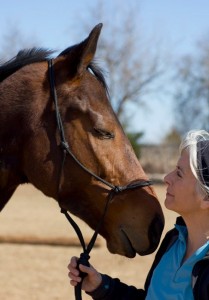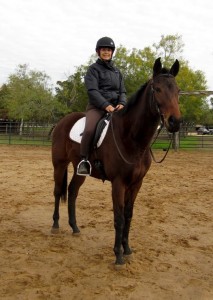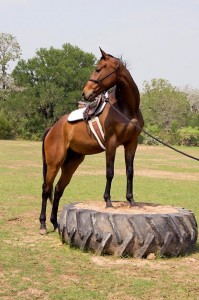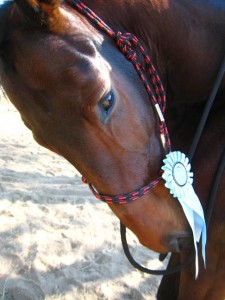Some might say Redabyebye was once a horse with a pile of cards stacked against him.
As racehorses go, he wasn’t all that good. And, he ran in low claimers at Ruidoso Downs in New Mexico, a racetrack recently investigated by the New York Times for its high rate of death and injury to jockeys and horses.
In seven starts, Redabyebye hit the board only once, winning a mere $1,800 for a second-place finish. With such a poor showing at a track so near to Mexican slaughterhouses, his fate could have been in question.
Yet, the stars aligned for this sweet-faced bay, bringing him the riches of good people, who sought only to do the right thing for him.
“His (race) owner really cared a lot about him. When she decided to retire him after seven starts, it was because they thought he was starting to develop a knee problem—they played it super safe,” says Syb Miller, Red’s new owner.
“If you think about it,” Miller adds, “he was racing at a New Mexico track that has been in the news” for horse deaths and other scandals “and yet, this goes to show that even at a track we read about, there are good people there, looking out for their horses.”
Red, as he is nicknamed, was packed up and shipped northward, to retire at Texas LOPE (LoneStar Outreach to Place ExRacers), where pristine fields and loving care awaited.
Race name: Redabyebye
Sire: Red
Dam: Fairway Pursuit
Foal date: Feb. 8, 2007By this point, it was Nov. 2010, and Miller had been in her own race, of sorts, giving it all to a 27-year career at St. Edward’s University. Her devotion to work teaching photocommunications, as well as her extracurricular activities in art, writing, and music and video installations, were all all consuming.
Even her downtime had her up in the air, flying to points near and far, for seminars and research.
At age 54, she decided to expand her horizons: It was time to make good on her childhood dream of owning a horse who “looked like Man o’ War,” she says.
Growing up, Miller was one of the lucky girls who convinced her parents to get her a pony, and later a horse. But as much as she loved her Shetland, and later, a Quarter Horse and an Appaloosa, it was the majestic Thoroughbred she desired.
“I remember when my dad took me to get my first horse, after I’d graduated up from my pony. I told him, ‘I want that horse over there, who’s running; he was a Thoroughbred,” Miller says. “But he said, ‘No, look over here, at this Quarter Horse.”
When she recently decided to start shopping for an ex-racehorse Thoroughbred, it was not without some experience under her belt. She had ridden a friend’s Thoroughbred for a few years, and in the feel of him, the lightness, and his willingness to work, she knew that this was what she’d been missing.
And when she saw Red’s picture a short time later on the LOPE website, she nearly leapt at the chance to fulfill her dream.
She met him. She looked at other horses, just in case, and snapped Red up. “He just had a real presence,” she notes.
Miller would often gaze at her horse and wonder what his life on the track had been like. Her curiosity prodded her to research the racing world, contacting his former owner for a more complete picture of her horse.
What she found was both delightful and alarming. On the plus side, Red’s owner was found to be one of the “good ones,” someone who could be trusted to put the horse first, she says.
Her horse had had good care.
But not all horses were so lucky, she discovered. As Miller researched the darker side of racing, and issues related to slaughter and drugging, she vowed to take the best possible care of her prized gelding.
From the start, Miller sought to work gently with her horse. Never forcing, but rather asking, going by “feel” and not “pressure.”
Working with a Natural Horsemanship trainer, she learned “how light I can be in my approach” when working with horses.
Together, she and Red went through training “through play” that de-sensitized him to spooky or scary situations, and encouraged him to become a respectful and responsive partner.
“For example, we got a big, horse-sized soccer ball for him to play with. At first he was a little afraid of it. Then he started to play with me, and my trainer,” Miller explains. “He’d push it to her, and she’d push it back. Then he’d push it to me. And we repeated this until he got bored with it.”
In this manner, Red has learned to stand with all four feet on a large, dirt-filled tire obstacle, to cross bridges, and to navigate calmly through all sorts of spooky situations.
He has also learned ground manners that any private-school parent would be glad to see their child emulate. He doesn’t tug or pull when walking, and he waits patiently at mealtime.
“Red walks away from his feed bucket at feeding time to give me space, and then comes back, with his ears up, when I give the OK,” she says.
Their progress dovetailed naturally into riding lessons last fall that focused on the biomechanics of movement. Red was taught how to balance himself, and find his body’s own equilibrium, Miller says.
“Like a lot of horses, he was fairly balanced in one direction, but a mess in the other—he was hollow, inverted and frustrated,” she says. “Slowly, he learned to seek the comfort of his own sense of his body-in-balance, and now he’s going beautifully in both directions, at all gaits.”
Their work has bonded her closer to this animal than any other she has known. And, because of what Red has shown her about the goodness of racehorses, Miller has also become an outspoken opponent of horse slaughter.
Despite a busy teaching schedule, she finds time to manage a website called [RIP Deputy Broad], which was named after a racehorse who was allegedly slaughtered in Canada.
Through Facebook and other social media, she uses the site as a repository to share news pertaining to the horse industry, and slaughter. She hopes the site will help raise awareness about issues, good and bad, in the Thoroughbred racing industry.
A fan of racing, Miller further hopes that positive change is coming, and that all the success stories of ex-racehorses in second careers, help turn the tide.
For she never forgets that Red’s fate could have been grim, indeed. Were it not for the good people who cared for him, and the fact he was never claimed, he could have wound up at a processing plant in nearby Mexico, she says.
“It could have wound up so differently for Red. He ran in cheap claimers and anybody could have claimed him,” she says. “I look at him, and his life, as a gift.”





